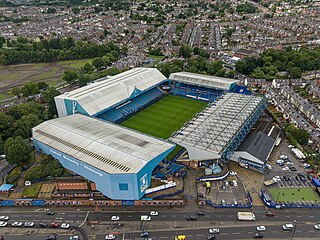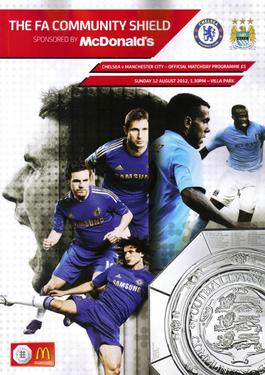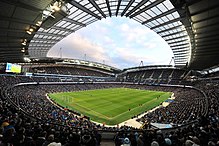
Hillsborough Stadium is a football stadium in Sheffield, England. It has been the home of Sheffield Wednesday since opening in 1899.

Manchester City Football Club is a professional football club based in Manchester, England, that competes in the Premier League, the top flight of English football. Founded in 1880 as St. Mark's , they became Ardwick Association Football Club in 1887 and Manchester City in 1894. The club's home ground is the City of Manchester Stadium in east Manchester, to which they moved in 2003, having played at Maine Road since 1923. Manchester City adopted their sky blue home shirts in 1894, the first season with the current name. Over the course of its history, the club has won nine league titles, seven FA Cups, eight League Cups, six FA Community Shields, one UEFA Champions League, one European Cup Winners' Cup, one UEFA Super Cup and one FIFA Club World Cup.

Burton Albion Football Club is a professional association football club in the town of Burton upon Trent, Staffordshire, England. The team compete in League One, the third level of the English football league system. The club moved its home ground in 2005 to the Pirelli Stadium from Eton Park. The club's nickname, The Brewers, evokes the brewing heritage of Burton upon Trent.

The City of Manchester Stadium is the home of Premier League club Manchester City, with a domestic football capacity of 53,400, making it the 6th-largest football stadium in England and 11th-largest in the United Kingdom.

Old Trafford is a football stadium in Old Trafford, Greater Manchester, England, and the home of Manchester United. With a capacity of 74,310 it is the largest club football stadium in the United Kingdom, and the twelfth-largest in Europe. It is about 0.5 miles (800 m) from Old Trafford Cricket Ground and the adjacent tram stop.

Elland Road is a football stadium in Beeston, Leeds, West Yorkshire, England, which has been the home of Championship club Leeds United since the club's formation in 1919. The stadium is the 13th largest football stadium in England.

Joseph Mercer was an English footballer and manager. Mercer, who played as a defender for Everton and Arsenal in his footballing career, also went on to manage Aston Villa and Manchester City, and was the caretaker manager of the England national football team.

Frank Victor Swift was an English footballer, who played as a goalkeeper for Manchester City and England. After starting his career with local clubs near his home town of Blackpool, in 1932 he was signed by First Division Manchester City, with whom he played his entire professional career.

Hyde Road was a football stadium in West Gorton, Manchester, England. It was home to Manchester City F.C. and their predecessors from its construction in 1887 until 1923, when the club moved to Maine Road. It was named after Hyde Road, a road which begins at the east end of Ardwick Green South in Ardwick and runs east towards Hyde. At the boundary between Gorton and Denton it continues as Manchester Road.

The Manchester derby refers to football matches between Manchester City and Manchester United, first contested in 1881. City play at the Etihad Stadium in Bradford, east Manchester, while United play at Old Trafford in the borough of Trafford, Greater Manchester; the two grounds are separated by approximately 4 miles (6.4 km). The teams have played 192 matches in all competitions, United winning 78, City 61, and the remaining 53 having been drawn. Amongst the most successful clubs in England, they have won a combined 101 honours: 67 for Manchester United and 34 for Manchester City.

North Road was a football and cricket ground in Newton Heath, Manchester, England. It was the first home of Manchester United Football Club – then known as Newton Heath Lancashire & Yorkshire Railway Football Club – from its foundation in 1878 until 1893, when the club moved to a new ground at Bank Street, Clayton.

Bank Street, also known as Bank Lane, was a multi-purpose stadium in Clayton, Manchester, England. It was mostly used for football matches and was the second home ground of Manchester United Football Club, after North Road, which they left in 1893. The stadium had a capacity of around 50,000, but the club moved to Old Trafford in 1910 because club owner John Henry Davies believed he could not sufficiently expand the ground.

Royston James Clarke was a Welsh footballer who played for Cardiff City, Manchester City, Stockport County and Wales as a winger.

Pirelli Stadium is an association football stadium on Princess Way in Burton upon Trent, Staffordshire, England. It was built in 2005 and is the current home of Burton Albion FC, replacing the club's old Eton Park home, also on Princess Way, which was demolished and developed into housing. The ground was built on the former site of the Pirelli UK Tyres Ltd Sports & Social Club, and having had the land donated to the club by Pirelli, in return for naming rights, the ground cost £7.2 million to build.
Manchester City Football Club, an English professional association football club, has gained entry to Union of European Football Associations (UEFA) competitions on multiple occasions. They have represented England in the European Cup on fourteen occasions, the UEFA Cup on eight occasions, in the now-defunct Cup Winners' Cup twice, the UEFA Super Cup once, and at the FIFA Club World Cup once. Manchester City are one of thirteen English football clubs to have won European and worldwide titles, in City's case the 1969–70 Cup Winners' Cup, 2022–23 Champions League, 2023 Super Cup, and 2023 Club World Cup.
This page chronicles the history of Manchester City in further detail from 1965 to 2001. See History of Manchester City F.C. for a history overview of Manchester City.
This page chronicles the history of Manchester City in further detail from its early years in 1880 to 1928. See Manchester City F.C. for an overview of the football club.

The 2012 FA Community Shield was the 90th FA Community Shield, a football match played on 12 August 2012 between the winners of the previous season's Premier League and FA Cup competitions. The match was contested by the 2012 FA Cup winners, Chelsea, and the champions of the 2011–12 Premier League, Manchester City.
Before Manchester City Football Club moved into their first permanent home in Manchester, England, in 1887, the club played at a short series of grounds which ranged from established cricket venues to bumpy fields with no stands or boundaries nor history of sporting usage. The club was founded as a philanthropic endeavour to encourage impressionable youths to commit to wholesome activities rather than falling to the local adolescent culture of alcohol and violence. The sport of football was barely 15 years from the writing of its own rulebook. The club had no immediate option of using or constructing a stadium, and thus most of their first locations were nothing more than painted lines and goalposts. As the club reformed and changed its name twice between 1880 and 1887, so its choice of locations were a series of low-cost, short-term solutions when their current location became untenable. In 1887, when City moved to their sixth pitch in only eight years, they had the money, ambition, reputation and stability to construct themselves a more permanent base of operations, at the stadium named Hyde Road.
























